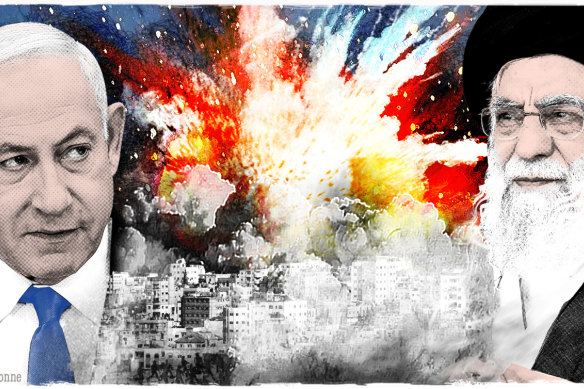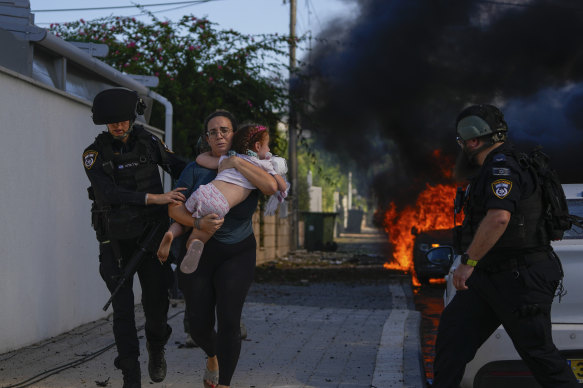Save articles for later
Add articles to your saved list and come back to them any time.
At first glance, the war in the Levant is simply a savage new round in the same old struggle between Israel and the Palestinians. The first glance is misleading.
A much bigger contest is afoot, with much bigger stakes. “Iran’s strategy has been all along to encircle Israel, just as the US has sought to encircle Iran,” explains ANU professor emeritus of Middle East studies, Amin Saikal.
Illustration: Dionne Gain. Credit:
In recent months, the US has been edging closer to achieving its aim. The last piece of the puzzle was nearing completion – under Washington’s aegis, Israel has been negotiating a normalisation of ties with Saudi Arabia, bringing the two traditional foes together.
This is a nightmarish prospect for Tehran. Friendly ties between Israel, the Saudis and the Americans would represent an entente cordiale between Iran’s three greatest enemies. Or, from Tehran’s point of view, it would be an axis of its enemies.
Iran’s ambitions to become the dominant power in the Middle East would turn to ash. So the ayatollahs decided to wreck the plan by launching a massive attack on Israel. Not directly, but by using Iran’s proxy forces abroad.
It began active planning in April, when the head of its Islamic Revolutionary Guard Corps’ elite Quds Force, Esmail Qaani, convened clandestine meetings in the Iranian embassy in Beirut with three of its terrorist proxies – Hamas, Hezbollah and Palestinian Islamic Jihad.
This intensified a couple of months ago: “Representatives of these groups have met with Quds Force leaders at least biweekly in Lebanon since August to discuss this weekend’s attack on Israel and what happens next,” revealed the Wall Street Journal on the weekend. Iran’s minister for foreign affairs, Hossein Amir-Abdollahian, was present for at least two of these meetings.
It’s unusual for the three militia groups to co-operate. Hamas is a Sunni Muslim organisation. The others, like Iran itself, are Shiite Muslim. It was Hamas, armed and financed by Iran, that conducted Saturday’s strike, the most murderously effective attack on Israel since the Yom Kippur War 50 years ago.
If there were any shadow of doubt that Hamas was acting hand-in-glove with Tehran, Hamas spokesman Ghazi Hamad on Saturday told the BBC “that the group had direct backing for the attack from Iran”. And in Tehran, Yahya Rahim Safavi, senior military adviser to Iran’s supreme leader, Ayatollah Ali Khamenei, said that Iran would continue to support Hamas “until the liberation of Palestine and Jerusalem”.
Four days before Saturday’s invasion, the supreme leader himself said: “The usurper regime is coming to an end. Today, the Palestinian youth and the anti-oppression, anti-occupation movement in Palestine is more energetic, more alive, and more prepared than ever during the past 70 or 80 years. God willing, the movement will achieve its goal.”
Police officers evacuate a woman and a child from a site hit by a rocket fired from the Gaza Strip, in Ashkelon.Credit: AP
Until Saturday, the uneasy coexistence between Hamas in the Gaza Strip and Israel was one of “not peace, not war,” in Saikal’s words. On Saturday, says Natan Sachs of Washington’s Brookings Institution: “Hamas broke the rules.”
Breaking out of the long-running pattern of limited hostilities into full-scale war, Hamas mounted mass missile barrages and ground attacks on 22 towns, invading residential streets, killing civilians and taking hostages.
How does this help the ayatollahs in Tehran? The moment Israel’s air force began its reprisal attacks on Hamas, with missiles striking the Palestinian enclave of Gaza, it became untenable for Saudi Arabia to be seen cosying up to the “Zionist regime”. For now, at least, any rapprochement between Riyadh and Jerusalem is impossible. Iran, as a result, is no longer in imminent danger of encirclement.
Abruptly, Israel is the country in danger of encirclement. It will face an “existential threat” if Iran activates its hydra-headed network of extraterritorial militias in co-ordinated assaults, Israel’s former national security adviser, Giora Eiland, said on Sunday.
Indeed, Amin Saikal says that Israel will be in dire straits if even just one more Iranian-backed guerrilla force attacks it now. “The risk of encirclement of Israel is there only if Hezbollah [based in Lebanon, on Israel’s northern border] enters the fight. It is in possession of more than 100,000 missiles, some quite sophisticated, long-range missiles. And we know that in the 2006 war between Israel and Hezbollah, Israel tried to destroy Hezbollah but it only emerged stronger.
“So far, the exchange of fire between Israel and Hezbollah on the weekend has been very carefully calculated to not lead to a major conflict. But if the Hamas war with Israel goes on for more than two or three weeks, Hezbollah will come under pressure from its own fighters to join the war.”
Iran also has other forces at its disposal, including militias in Syria, that it can activate without having to directly engage Israel. The ayatollah is in a strong position to escalate should he choose to do so. Israel could be at risk of dismemberment under assault from multiple sides.
The US, seeing Israel’s vulnerability, has ordered forces including aircraft carrier battle groups to steam close and stand ready to deter any further aggression against its ally. This is partly to convince the American audience at home that the Biden administration is committed to the defence of Israel, but it’s also designed to discourage Iran from a direct, opportunistic attack on Israel.
Two other great powers, Russia and China, have their own relationships with Iran. Saikal calls them “de facto allies”. Moscow would be only too happy to see the US entangled in any intensification of the Israel war; that would draw away American resources and attention from Ukraine.
And Beijing would be happy to see Washington distracted, too, giving Xi Jinping a freer hand to operate against any of the nations it’s currently antagonising, whether the Philippines, Vietnam, Japan or the self-governed island of Taiwan.
So this is a new and serious source of strife and danger in a world that already had more than enough of both.
Peter Hartcher is international editor.
Get a weekly wrap of views that will challenge, champion and inform your own. Sign up for our Opinion newsletter.
Most Viewed in World
From our partners
Source: Read Full Article


